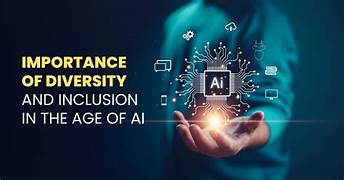AI for Promoting Diversity and Inclusion: Shaping a More Equitable Future
Artificial Intelligence (AI) is rapidly transforming various industries, offering innovative solutions that can address complex problems and enhance human capabilities. While much attention has been focused on the potential risks and challenges posed by AI, it is also a powerful tool that can drive positive social change. One of its most promising applications lies in promoting diversity and inclusion across different sectors of society. By leveraging AI to create more equitable environments, organizations, governments, and individuals can help break down long-standing barriers and address systemic discrimination.
This article explores how AI can promote diversity and inclusion, the challenges that must be overcome, and the importance of using AI responsibly to achieve these goals. It highlights real-world applications, opportunities, and considerations to ensure that AI becomes a force for good in creating a more inclusive world.
Understanding Diversity and Inclusion
Before diving into how AI can foster diversity and inclusion, it’s important to understand the terms and their significance. Diversity refers to the presence of differences within a given setting, encompassing various dimensions such as race, ethnicity, gender, sexual orientation, age, disability, religion, socioeconomic status, and more. Inclusion, on the other hand, is the practice of creating environments in which all individuals, regardless of their background or identity, feel valued, respected, and able to contribute fully.
In many sectors, there is a growing recognition of the need for diversity and inclusion as key factors for success. A diverse workforce is linked to enhanced creativity, improved decision-making, and better problem-solving. Inclusive practices foster a sense of belonging, which boosts employee engagement, satisfaction, and retention. However, achieving true diversity and inclusion has historically been a challenge, as bias and discrimination persist at various levels, from hiring practices to organizational culture.
AI, if implemented thoughtfully, can play a pivotal role in breaking down these barriers and creating more inclusive environments.
How AI Can Promote Diversity and Inclusion
AI’s potential for promoting diversity and inclusion is vast and spans several areas, including recruitment and hiring, employee retention, workplace culture, education, and social equity. By eliminating biases, identifying systemic issues, and providing insights into inequality, AI can help create more inclusive systems. Below are some of the key ways in which AI is being used to promote diversity and inclusion:
1. Reducing Bias in Recruitment and Hiring
One of the most prominent applications of AI in promoting diversity and inclusion is in the recruitment and hiring process. Traditional hiring methods have often been fraught with unconscious biases that favor certain demographics, such as race, gender, and socioeconomic background. These biases can influence decisions about job candidates, resulting in inequitable representation in the workforce.
AI-powered recruitment tools can help mitigate these biases by anonymizing resumes, using algorithms to assess candidates based on skills and qualifications rather than personal characteristics. For instance, AI can help screen resumes in a way that removes gendered language or other markers of identity, ensuring that candidates are evaluated solely on their professional capabilities.
Moreover, AI can also assist in identifying patterns of discrimination in hiring practices, offering companies insights into potential gaps in diversity and inclusion. These insights can help organizations take targeted actions to improve representation and ensure that hiring processes are fair and equitable.
2. Promoting Inclusive Workplace Culture
AI can also be used to monitor and improve workplace culture. With the help of natural language processing (NLP) and sentiment analysis tools, AI can analyze employee feedback from surveys, emails, and other communication channels to detect issues related to inclusion and discrimination. By identifying patterns in employee sentiment, AI can help organizations pinpoint areas where employees feel excluded, marginalized, or discriminated against.
For example, if an organization notices recurring mentions of gender or racial bias in employee feedback, it can take proactive steps to address these concerns, such as implementing targeted training, creating more inclusive policies, or fostering open conversations about diversity and inclusion.
Additionally, AI-powered chatbots can facilitate conversations about sensitive topics related to diversity and inclusion. These bots can provide employees with anonymous platforms to report issues, seek advice, or access resources that promote inclusivity.
3. Ensuring Equal Access to Opportunities
AI can also be used to ensure that all individuals, regardless of their background or identity, have equal access to opportunities. For example, in the field of education, AI can help identify and address disparities in student performance, providing personalized learning experiences that cater to the diverse needs of students.
In higher education, AI-driven systems can analyze data on student outcomes to identify factors contributing to achievement gaps among different groups, such as socioeconomic status, race, or disability. By recognizing these disparities, educational institutions can design more inclusive curricula, offer tailored support services, and ensure that all students have the tools they need to succeed.
In the workplace, AI can support professional development by identifying underrepresented groups within organizations and recommending targeted mentorship or training programs. AI-driven analytics can also help organizations track career progression, ensuring that all employees have equal access to promotions, raises, and career advancement opportunities.
4. Fostering Representation in Media and Technology
Representation in media and technology is critical to shaping perceptions and influencing societal norms. However, marginalized groups have historically been underrepresented or misrepresented in both domains. AI can play a key role in ensuring more diverse and inclusive representation by analyzing content, identifying gaps in diversity, and helping media organizations create more balanced and accurate portrayals of different communities.
AI algorithms can be used to analyze the representation of gender, race, ethnicity, and other identities in movies, TV shows, advertisements, and news coverage. If discrepancies are identified, AI tools can suggest content or casting choices that better reflect the diversity of society. This can help prevent stereotypes and promote positive portrayals of underrepresented groups.
In the tech industry, AI can also contribute to creating more inclusive products. By ensuring that AI systems are trained on diverse datasets, developers can reduce the risk of reinforcing biases in technologies such as facial recognition, voice assistants, and automated decision-making systems. Ensuring that AI systems are designed with inclusivity in mind is crucial for promoting diversity in tech and creating products that serve the needs of all users.
5. Enhancing Accessibility for People with Disabilities
AI has the potential to significantly improve accessibility for individuals with disabilities. AI-powered tools such as speech recognition, real-time captioning, and sign language recognition can break down communication barriers, allowing people with disabilities to participate more fully in education, work, and social activities.
For instance, AI-based assistive technologies, such as screen readers, help individuals with visual impairments navigate websites and digital content. AI-powered transcription services allow individuals who are deaf or hard of hearing to access real-time captions during meetings or online events. These technologies promote inclusion by ensuring that people with disabilities have equal access to information, opportunities, and services.
Challenges in Using AI for Diversity and Inclusion
While AI offers great potential for promoting diversity and inclusion, it is not without its challenges. One of the key concerns is the potential for reinforcing biases rather than eliminating them. AI systems are trained on data, and if the data used to train AI models is biased or unrepresentative, the AI can perpetuate those biases. For example, if an AI recruitment tool is trained on historical hiring data that reflects a preference for male candidates, the tool may inadvertently favor male applicants in future hiring decisions.
To mitigate this risk, it is essential to ensure that AI models are trained on diverse, representative datasets and that the algorithms are regularly audited to check for bias. Developers must also ensure that AI systems are designed to prioritize fairness, equity, and transparency.
Another challenge is ensuring that AI technologies are accessible and usable by all individuals, regardless of their socioeconomic background or technological literacy. As AI becomes increasingly integrated into various sectors, there is a risk that marginalized communities may be left behind if they do not have access to the necessary tools and resources to benefit from these advancements.
The Future of AI in Diversity and Inclusion
As AI continues to evolve, its potential to drive positive change in promoting diversity and inclusion will only grow. The key to harnessing AI for good lies in ensuring that it is developed and deployed responsibly, with a focus on equity, fairness, and transparency. Governments, businesses, and individuals must collaborate to ensure that AI technologies are designed to reflect the values of inclusivity and diversity.
By using AI to reduce bias, ensure equal access to opportunities, and foster inclusive environments, we can create a world where diversity is celebrated, and everyone has the opportunity to thrive. Ultimately, AI has the potential to be a powerful tool in building a more equitable and inclusive future, one where individuals are judged by their abilities, not their identity, and where every voice is heard and valued.
In conclusion, AI holds immense promise in advancing diversity and inclusion across various sectors. By addressing systemic discrimination, promoting equal opportunities, and enhancing representation, AI can help create more inclusive environments where everyone can succeed. However, careful oversight and ethical development of AI technologies are essential to ensure that these tools are used responsibly and that they contribute to building a more diverse, equitable, and inclusive world.


